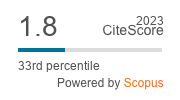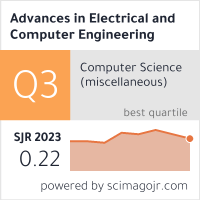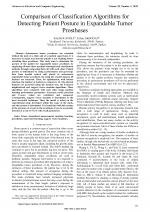| 2/2020 - 15 | View TOC | « Previous Article | Next Article » |
Comparison of Classification Algorithms for Detecting Patient Posture in Expandable Tumor ProsthesesKOCAOGLU, S. |
| View the paper record and citations in |
| Click to see author's profile in |
| Download PDF |
Author keywords
biomedical measurement, machine learning, prosthetics, supervised learning, support vector machines
References keywords
recognition(19), posture(13), activity(12), wearable(11), detection(9), sensors(8), comput(8), biomed(8), system(7), human(7)
Blue keywords are present in both the references section and the paper title.
About this article
Date of Publication: 2020-05-31
Volume 20, Issue 2, Year 2020, On page(s): 131 - 138
ISSN: 1582-7445, e-ISSN: 1844-7600
Digital Object Identifier: 10.4316/AECE.2020.02015
Web of Science Accession Number: 000537943500015
SCOPUS ID: 85087436149
Abstract
Autonomous tumor prostheses are extended without the need of a clinic and of a medical supervision. It is necessary to make sure that the patient is not standing before extending these prostheses. This study aims to determine the posture of the patient for expandable tumor prostheses by employing oft-used three machine learning-based classification methods through comparing them all with each other. Patient posture is determined by using accelerometer and gyroscope data from inertial control unit placed in autonomous expandable tumor prosthesis. By using the created dataset, 48 features are extracted. Then, for optimization, with feature selection, the number of features is reduced to 10. The selected features are processed using the decision tree, the k-nearest neighborhood and support vector machine algorithms. These algorithms were compared with each other using machine learning performance parameters. Accuracy, recall, precision and F-score values are calculated and compared. Consequently, support vector machine is determined as the most successful technique. Then, the model is tested on the experimental setup developed within the scope of the study, and the posture is determined. It is found that with this system, in the presence of a load on the prosthesis, it can be accurately detected at a rate of 97.1% (the recall parameter). |
| References | | | Cited By «-- Click to see who has cited this paper |
| [1] G. J. S. Verkerke, "Design of a lengthening element for a modular femur endoprosthetic system," J Eng Med,vol. 203 pp. 97-102, 1989. [CrossRef] [SCOPUS Times Cited 11] [2] G. J. S. Verkerke, H. S. Koops, R. P. H. Veth, H. H. van den Kroonenberg, H.J. Grootenboer, H. K. L. Nielsen, J. Oldhoff and A. Postma, "An extendable modular endoprosthetic system for bone tumour management in the leg," J Biomed Eng vol. 6 pp.12:19, 1990. [CrossRef] [Web of Science Times Cited 10] [SCOPUS Times Cited 17] [3] M. D. Neel, R. M. Wilkins, B. N. Rao, C. M. Kelly, "Early Multicenter Experience With a Noninvasive Expandable Prosthesis," Clin Orthop Relat Res vol. 415 pp. 72-81. 2003. [CrossRef] [Web of Science Times Cited 79] [SCOPUS Times Cited 109] [4] A. Gupta, J. Meswania, R. Pollock, S.R. Cannon, T. W. R. Briggs, S. Taylor and G. Blunn, "Non-invasive distal femoral expandable endoprosthesis for limb-salvage surgery in paediatric tumours," J Bone Joint Surg Br, vol. 88 pp. 649-654. 2006. [CrossRef] [Web of Science Times Cited 78] [SCOPUS Times Cited 95] [5] J. M. Meswania, S. J. G. Taylor, and G. W. Blunn, "Design and characterization of a novel permanent magnet synchronous motor used in a growing prosthesis for young patients with bone cancer.," Proc. Inst. Mech. Eng. Part H-Journal Eng. Med., vol. 222, no. 3, pp. 393-402, 2008. [CrossRef] [Web of Science Times Cited 10] [SCOPUS Times Cited 13] [6] P. Borkowski, K. Skalski, "Expandable endoprosthesis for growing patients-Reliability and research," Biocybern Biomed Eng vol. 34, pp. 199-205. 2014. [CrossRef] [Web of Science Times Cited 4] [SCOPUS Times Cited 4] [7] K. K. Sarma, "Neural network based feature extraction for assessment character and numeral recognition, International Journal of Artificial Intelligence. 2009, 2 (S09): 37-56. [8] C. Pozna, R.-E. Precup, J.K. Tar, I. Skrjanc, S. Preitl, "New results in modelling derived from Bayesian filtering Knowledge-Based Systems", 23 (2) (2010), pp. 182-194. [CrossRef] [Web of Science Times Cited 67] [SCOPUS Times Cited 78] [9] Alvarez Gil R. P., Johanyak Z. C., Kovacs T. Surrogate model based optimization of traffic lights cycles and green period ratios using microscopic simulation and fuzzy rule interpolation International Journal of Artificial Intelligence. 2018, 16 (1), pp. 20-40. [10] Albu A, Precup R.E, Teban T.A. Results and challenges of artificial neural networks used for decision-making and control in medical applications. FU Mech Eng. 2019; 17(3): 285-308. [CrossRef] [Web of Science Times Cited 96] [SCOPUS Times Cited 108] [11] D. Yang, J. Huang, X. Tu, G. Ding, T. Shen, X. Xiao, "A Wearable Activity Recognition Device Using Air-Pressure and IMU Sensors," IEEE Access vol. 7 pp. 6611-6621, 2019. [CrossRef] [Web of Science Times Cited 25] [SCOPUS Times Cited 33] [12] D. RodrÃguez-MartÃn, C. Perez-Lopez, A. Sama, J. Cabestany, A. Català , "A wearable inertial measurement unit for long-term monitoring in the dependency care area." Sensors (Switzerland) vol. 13 pp. 14079-14104, 2013. [CrossRef] [Web of Science Times Cited 56] [SCOPUS Times Cited 63] [13] T. Nguyen Gia, V. K. Sarker, I. Tcarenko, A. M. Rahmani, T. Westerlund, P. Liljeberg, H. Tenhunen, "Energy efficient wearable sensor node for IoT-based fall detection systems," Microprocess Microsyst vol. 56, pp. 34-46, 2018 [CrossRef] [Web of Science Times Cited 91] [SCOPUS Times Cited 122] [14] Y. Ma, N. Amini, H. Ghasemzadeh, "Wearable sensors for gait pattern examination in glaucoma patients," Microprocess Microsyst vol. 46 pp. 67-74, 2016. [CrossRef] [Web of Science Times Cited 9] [SCOPUS Times Cited 10] [15] S. Afifi, H. G. Hosseini, R.A. Sinha, "A system on chip for melanoma detection using FPGA-based SVM classifier," Microprocess Microsyst, vol. 65 pp. 57-68, 2019. [CrossRef] [Web of Science Times Cited 33] [SCOPUS Times Cited 45] [16] A. Alvarez-Alvarez, G. Trivino, O. Cordón, "Body posture recognition by means of a genetic fuzzy finite state machine," in IEEE 5th Int Work Genet Evol Fuzzy Syst, 2011, pp. 60-65. [CrossRef] [SCOPUS Times Cited 32] [17] G. Diraco, A. Leone, P. Siciliano, "An active vision system for fall detection and posture recognition in elderly healthcare," Proc. Conf. Des. Autom. Test Eur., EDAA; 2010, pp. 1536-1541. [CrossRef] [SCOPUS Times Cited 114] [18] M. Yu, A. Rhuma, S. M. Naqvi, L. Wang, J. Chambers, "A posture recognition-based fall detection system for monitoring an elderly person in a smart home environment," IEEE Trans Inf Technol Biomed, 2012, pp. 1274- 1286. [CrossRef] [Web of Science Times Cited 211] [SCOPUS Times Cited 274] [19] B. Boulay, F. Bremond, M. Thonnat, "Applying 3D human model in a posture recognition system," Pattern Recognit Lett, vol. 27, pp. 1788-1796, 2006. [CrossRef] [Web of Science Times Cited 39] [SCOPUS Times Cited 45] [20] T. L. Le, M. Q. Nguyen, T. T. M. Nguyen, "Human posture recognition using human skeleton provided by Kinect," Int Conf Comput Manag Telecommun:ComManTel2013, 2013, pp. 340-345. [CrossRef] [SCOPUS Times Cited 115] [21] C. Chi-Wei, I. Cohen, "Posture and Gesture Recognition using 3D Body Shapes Decomposition," IEEE Comput Soc Conf Comput Vis Pattern Recognit - Work , 2006, 69-76. [CrossRef] [SCOPUS Times Cited 28] [22] N. Foubert, A. M. McKee, R. A. Goubran, F. Knoefel, "Lying and sitting posture recognition and transition detection using a pressure sensor array, IEEE Symp Med Meas Appl Proc 2012, pp. 65-70. [CrossRef] [SCOPUS Times Cited 44] [23] J. Huang, X. Yu, Y. Wang, X. Xiao, "An integrated wireless wearable sensor system for posture recognition and indoor localization," Sensors (Switzerland), vol. 16, pp. 1-24, 2016. [CrossRef] [Web of Science Times Cited 35] [SCOPUS Times Cited 46] [24] H. Gjoreski, M. Lustrek, M. Gams, "Accelerometer placement for posture recognition and fall detection," Proc -7th Int Conf Intell Environ IE 2011, pp. 47-54. [CrossRef] [SCOPUS Times Cited 179] [25] F. R. Allen, E. Ambikairajah, N. H. Lovell, B. G. Celler, "Classification of a known sequence of motions and postures from accelerometry data using adapted Gaussian mixture models," Physiol Meas, vol. 27, pp. 935-951, 2006. [CrossRef] [Web of Science Times Cited 116] [SCOPUS Times Cited 153] [26] E. S. Sazonov, G. Fulk, J. Hill, Y. Schutz, R. Browning, "Monitoring of posture allocations and activities by a shoe-based wearable sensor," IEEE Trans Biomed Eng, 2011, vol. 58 pp. 983-990. [CrossRef] [Web of Science Times Cited 161] [SCOPUS Times Cited 200] [27] J. Chen, J. Qiu, C. Ahn, "Construction worker's awkward posture recognition through supervised motion tensor decomposition." Autom Constr, vol. 77, pp. 67-81, 2017. [CrossRef] [Web of Science Times Cited 116] [SCOPUS Times Cited 139] [28] S. Kocaoglu, E. Akdogan, "Design and development of an intelligent biomechatronic tumor prosthesis," Biocybern Biomed Eng, vol. 39, pp. 561-570, 2019. [CrossRef] [Web of Science Times Cited 3] [SCOPUS Times Cited 5] [29] K.K. Tan, S. Zhao, J.-X. Xu Online automatic tuning of a proportional integral derivative controller based on an iterative learning control approach IET Control Theory Appl., 1 (2007), pp. 90-96. [CrossRef] [Web of Science Times Cited 73] [SCOPUS Times Cited 84] [30] S. Preitl, R. E. Precup, Z. Preitl, S. Vaivoda, S. Kilyeni, and J. K.Tar, "Iterative feedback and learning control. Servo systems applications," IFAC Workshop ICPS07, vol. 40, no. 8, pp. 16-27, Jul. 9-11, 2007. [CrossRef] [SCOPUS Times Cited 92] [31] Ruiz-Rangel, J.; Hernandez, C.J.A.; Gonzalez, L.M.; Molinares, D.J. Ernead: Training of Artificial Neural Networks based on a Genetic Algorithm and Finite Automata Theory. Int. J. Artif. Intell. 2018, 16, 214-253. [32] A. Bulling, U. Blanke, B. Schiele, "A tutorial on human activity recognition using body-worn inertial sensors," ACM Comput Surv vol. 46 pp. 1-33, 2014. [CrossRef] [Web of Science Times Cited 969] [SCOPUS Times Cited 1181] [33] N. Ravi, N. Dandekar, P. Mysore, M. L. Littman, "Activity Recognition from Accelerometer Data," Procedia Technol vol. 7 pp. 248-56, 2013. [CrossRef] [Web of Science Times Cited 23] [34] E. M. Tapia, S.S. Intille, W. Haskell, K. Larson, J. Wright, A. King and R. Friedman, "Real-Time Recognition of Physical Activities and Their Intensities Using Wireless Accelerometers and a Heart Rate Monitor," 11th IEEE Int. Symp. Wearable Comput., IEEE; 2007, pp. 1-4. [CrossRef] [SCOPUS Times Cited 362] [35] Y. Liu, L. Nie, L. Liu, D. S. Rosenblum, "From action to activity: Sensor-based activity recognition," Neurocomputing vol. 181, pp. 108-115, 2016. [CrossRef] [Web of Science Times Cited 408] [SCOPUS Times Cited 448] [36] S. Halkiotis, T. Botsis, M. Rangoussi. "Automatic detection of clustered microcalcifications in digital mammograms using mathematical morphology and neural networks", Signal Processing, vol. 87, no. 7, pp. 1559-1568, 2007. [CrossRef] [Web of Science Times Cited 78] [SCOPUS Times Cited 94] [37] M. Hekim, A. A. Yurdusev, C. Oral. "The detection and classification of microcalcifications in the Visibility-Enhanced mammograms obtained by using the Pixel Assignment-Based spatial filter." Advances in Electrical and Computer Engineering, vol. 19, no. 4, pp. 73-82, 2019. [CrossRef] [Full Text] [Web of Science Times Cited 3] [SCOPUS Times Cited 3] [38] M. Ermes, J. Parkka, J. Mantyjarvi and I. Korhonen, "Detection of daily activities and sports with wearable sensors in controlled and uncontrolled conditions," IEEE Trans. Inf. Tech. Biomed, 2006, vol.12 pp 20-26. [CrossRef] [Web of Science Times Cited 478] [SCOPUS Times Cited 601] [39] J. Parkka, M. Ermes, P. Korpipaa, J. Mantyjarvi, J. Peltola and I. Korhonen "Activity classiï¬cation using realistic data from wearable sensors," IEEE Trans. Inf. Technol. Biomed., 2006, vol. 10, pp. 119-128. [CrossRef] [Web of Science Times Cited 475] [SCOPUS Times Cited 634] [40] N. Ravi, N. Dandekar, P. Mysore and M. Littman, "Activity recognition from accelerometer data," Proceedings of the 7th Innovative Applications of Artiï¬cial Intelligence Conference, 2005, pp. 11-18. [41] S. J. Preece, J. Y. Goulermas, L. P. J Kenney, D. Howard, K. Meijer and R. Crompton. "Activity identiï¬cation using body-mounted sensors-a review of classiï¬cation techniques", Physiological Measurement, vol. 30, R1, 2009. [CrossRef] [Web of Science Times Cited 402] [SCOPUS Times Cited 483] [42] S. J. Preece, J. Y. Goulermas, L. P. J. Kenney and D. Howard, "A comparison of feature extraction methods for the classiï¬cation of dynamic activities from accelerometer data," IEEE Trans. Biomed. Eng. vol. 36, pp. 871-879, 2008. [CrossRef] [Web of Science Times Cited 374] [SCOPUS Times Cited 468] [43] J. Fahrenberg, F. Foerster, M. Smeja and W. Muller, "Assessment of posture and motion by multichannel piezoresistive accelerometer recordings," Psychophysiology vol.34, pp. 607-12, 1997. [CrossRef] [Web of Science Times Cited 98] [SCOPUS Times Cited 117] [44] F. Foerster and J. Fahrenberg, "Motion pattern and posture: correctly assessed by calibrated accelerometers,"Behav. Res. Methods Instrum. Comput, vol.32 pp. 450-457, 2000. [CrossRef] [Web of Science Times Cited 117] [SCOPUS Times Cited 153] [45] J. B. Bussmann, W. L. Martens, J. H. Tulen, F. C. Schasfoort, H. J. van den Berg-Emons and H. J. Stam, "Measuring daily behavior using ambulatory accelerometry: the activity monitor," Behav. Res. Methods Instrum. Comput. vol. 33 pp. 349-356, 2001. [CrossRef] [Web of Science Times Cited 230] [SCOPUS Times Cited 266] [46] A. Krause, M. Ihmig, E. Rankin, D. Leong, S. Gupta, D. Siewiorek, A. Smailagic, M. Deisher and U. Sengupta, "Trading off prediction accuracy and power consumption for context-aware wearable computing," Proc. of the 9th IEEE International Symposium on Wearable Computers, 2005, pp 20-26. [CrossRef] [Web of Science Times Cited 87] [SCOPUS Times Cited 122] [47] Y. Kim and H. Ling, "Human Activity Classification Based on Micro-Doppler Signatures Using a Support Vector Machine," in IEEE Transactions on Geoscience and Remote Sensing, 2009, vol. 47, no. 5, pp. 1328-1337. [CrossRef] [Web of Science Times Cited 634] [SCOPUS Times Cited 763] [48] D. Anguita, A. Ghio, L. Onet, X. Parra, J. L. Reyes-Ortiz, "Human Activity Recognition on Smartphones Using a Multiclass Hardware-Friendly Support Vector Machine," In: Bravo J., Hervás R., RodrÃguez M. (eds) Ambient Assisted Living and Home Care. IWAAL, 2012. [CrossRef] [SCOPUS Times Cited 756] [49] N. Gopalakrishna, V. Krishnan, V. Gopalakrishnan, "Ensemble Feature Selection to Improve Classification Accuracy in Human Activity Recognition," In: Ranganathan G., Chen J., Rocha A. (eds) Inventive Communication and Computational Technologies. Lecture Notes in Networks and Systems, vol 89. Springer, Singapore, 2020. [CrossRef] [Web of Science Times Cited 3] [SCOPUS Times Cited 2] [50] I. Guyon, A. Elisseeff, "An Introduction to Variable and Feature Selection," An Introd to Var Featur Sel, vol. 3, pp. 1157-1182, 2003. [CrossRef] [Web of Science Times Cited 163] [SCOPUS Times Cited 197] [51] Y. W. Chen, C. J. Lin, "Combining SVMs with various feature selection strategies," Stud Fuzziness Soft Comput vol. 207 pp. 315-324, 2006. [CrossRef] [SCOPUS Times Cited 633] Web of Science® Citations for all references: 5,854 TCR SCOPUS® Citations for all references: 9,541 TCR Web of Science® Average Citations per reference: 113 ACR SCOPUS® Average Citations per reference: 183 ACR TCR = Total Citations for References / ACR = Average Citations per Reference We introduced in 2010 - for the first time in scientific publishing, the term "References Weight", as a quantitative indication of the quality ... Read more Citations for references updated on 2024-07-23 18:44 in 316 seconds. Note1: Web of Science® is a registered trademark of Clarivate Analytics. Note2: SCOPUS® is a registered trademark of Elsevier B.V. Disclaimer: All queries to the respective databases were made by using the DOI record of every reference (where available). Due to technical problems beyond our control, the information is not always accurate. Please use the CrossRef link to visit the respective publisher site. |
Faculty of Electrical Engineering and Computer Science
Stefan cel Mare University of Suceava, Romania
All rights reserved: Advances in Electrical and Computer Engineering is a registered trademark of the Stefan cel Mare University of Suceava. No part of this publication may be reproduced, stored in a retrieval system, photocopied, recorded or archived, without the written permission from the Editor. When authors submit their papers for publication, they agree that the copyright for their article be transferred to the Faculty of Electrical Engineering and Computer Science, Stefan cel Mare University of Suceava, Romania, if and only if the articles are accepted for publication. The copyright covers the exclusive rights to reproduce and distribute the article, including reprints and translations.
Permission for other use: The copyright owner's consent does not extend to copying for general distribution, for promotion, for creating new works, or for resale. Specific written permission must be obtained from the Editor for such copying. Direct linking to files hosted on this website is strictly prohibited.
Disclaimer: Whilst every effort is made by the publishers and editorial board to see that no inaccurate or misleading data, opinions or statements appear in this journal, they wish to make it clear that all information and opinions formulated in the articles, as well as linguistic accuracy, are the sole responsibility of the author.





